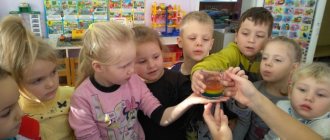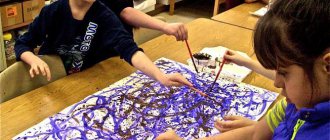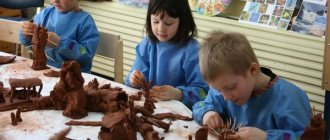“Methods and techniques for managing role-playing games for children”
Directing a role-playing game requires great skill and pedagogical tact. The teacher must direct the game without disturbing it, and maintain the independent and creative nature of the game activity.
Indirect techniques - without direct intervention in the game (bringing in toys, creating a play environment before the start of the game).
The integrated method of guidance is a system of pedagogical influences that promote the development of children’s independent story-based play, based on its age characteristics and the potential development of the child’s intelligence.
This method includes the following components:
— systematic pedagogically active enrichment of children’s life experience;
- joint (educational) games between the teacher and children, aimed at conveying to them the gaming experience of the traditional culture of play;
— timely changes in the subject-game environment, taking into account the enriching life and gaming experience;
- activating communication between an adult and children, aimed at encouraging them to independently use new ways of solving game problems and new knowledge about the world in the game.
Early age
Integrated Leadership Techniques:
- emotional communication between an adult and a child in joint play
- demonstration of methods of action with objects, accompanied by the speech of an adult;
- joint play activities with the teacher;
- inclusion of the teacher in the child’s play (to solve certain game problems);
- demonstration, training in the use of substitute objects, drawn markers of the playing space, imaginary objects in the game;
- use of activating dialogue between the teacher and the child;
— prompting questions.
Indirect leadership techniques:
— selection of toys with certain properties;
- examination of household items and objects of the immediate environment, conversation about their purpose;
- observation of the actions of adults using household items and objects of the immediate environment;
- various small errands for the child (bring a chair, hang a towel on a hook);
- involving the child in all possible participation in labor activities (cleaning up toys, things);
- examination of subject pictures, small plots and illustrations;
- creating a ready-made play environment (suggesting a situation - a doll and a cup are placed next to each other);
- changing a familiar game situation (replacing toys, adding new ones);
- the teacher poses a problem situation.
Principles for organizing role-playing games in kindergarten:
1 principle: in order for children to master gaming skills, the teacher must play with them.
Principle 2: the teacher should play with children throughout preschool childhood, but at each stage the game should be developed in such a way that the children immediately “discover” and assimilate a new, more complex way of constructing it.
Principle 3: starting from an early age and further at each stage of preschool childhood, when developing gaming skills, it is necessary to simultaneously orient the child both to the implementation of a gaming action and to explaining its meaning to partners - an adult or a peer.
Levels of development of role-playing play in preschoolers
First level. The central content of the game is predominantly objective actions. In fact, there are roles in the game, but they do not determine the actions, but themselves stem from the nature of the actions performed by the child. As a rule, there is no preliminary planning of the game: children do not name roles, but designate them only after performing a game action. Actions are monotonous and tend to be repeated many times; their logic is easily violated. The complex sequence of actions that make up role behavior is not reproduced by the child in the game.
Second level. The main content of the game is still objective actions. The game plays out a rather complex chain of actions. At the same time, the correspondence of the game action with the real one comes to the fore. The logic of actions is determined by their sequence in real life. The range of types of gaming activities is expanding. Substitution options are limited. Game renaming of objects is unstable; the new meaning of substitute objects is quickly lost. Children name roles, but the child’s acceptance of one or another role decisively determines the choice of a play object and the play action itself.
Third level. The main content of the game is the child’s fulfillment of a role and the actions associated with it. Preliminary planning of gaming activities, control over the fulfillment of roles and its correction arise. The roles are clear, precise, determined by the children before the start of the game and determine the logic and nature of the actions. Game actions appear that convey the nature of the simulated social relationships. These actions become varied, generalized, and are often performed only verbally. A specific role-playing speech arises, reflecting the relationship between the characters; the possibilities of substitution are expanding: the new game meaning of an object is quite stable, but only when the substitute object does not have a clearly fixed objective function. The rule is not presented in an explicit, open form, but actually regulates the fulfillment of roles and is updated when the logic of game actions is violated.
Fourth level. The central content of the game is to perform actions that reflect social and interpersonal relationships. Preliminary planning is carried out: the concept of the game is formulated, roles and game items are distributed, and sometimes the rules of the game are determined. The roles are clear and precise, their implementation is regulated by the rule. The speech is expressive, detailed and clearly of a role-playing nature. Actions are logical and varied, unfolding in a clear sequence. The share of speech acts is increasing. The child extracts rules from real life and demonstrates obedience to them in the game. Substitutions are widely used.
Junior preschool age
Second junior group
Integrated Leadership Techniques:
Teaching ways to reflect reality in games:
- inclusion of the teacher in the game (in order to convey gaming experience);
- teaching game actions and role-playing dialogue by example.
Activating communication between the teacher and children during the game:
— questions (Who are you? Or are you a driver? I’m late for work, please give me a lift);
— encouragement;
- encouragement to speak out (ask your daughter, she’s not hungry);
- help from the teacher to unite in the game (You are probably bored alone, invite Olya, she also goes for walks with her daughter).
Middle group
- inclusion of the teacher in the game, taking on the main or secondary roles (not often);
— the teacher’s entry into a role-playing conversation (in order to activate the role-playing dialogue).
Indirect leadership techniques:
Enriching the real experience of children in active activities:
- introducing vivid images and impressions into classes to familiarize yourself with the environment;
- excursions, observations, meetings with people of certain professions, accompanied by conversations with children;
- creating situations that encourage the child to enter into relationships with others (assignments);
- reading works of fiction, dramatizing fairy tales;
- watching other children play;
-reminders about interesting facts from life.
Organization of the subject-game environment:
- a combination of toys, substitute items, role attributes, imaginary toys;
- introducing a new toy into the environment;
- children making attributes for the game.
Enriching children's social experience in everyday life:
- getting to know the environment through active activities (observations, excursions, conversations, using TSO, reading literature, looking at illustrations and paintings);
- creation by the teacher of special situations in order to establish contacts between the child and others.
Organization of educational games by the teacher:
- theatrical games
- games like “Guess who came?” "Guess who I'm impersonating?"
— didactic games “Who needs what for work”
Creating a game problem situation:
— using gaming equipment (attributes, decorations, clothing, toys);
- through activating communication between the teacher and children;
— encouragement;
- attracting inactive children to the game.
Levels of development of role-playing play in preschoolers
First level. The central content of the game is predominantly objective actions. In fact, there are roles in the game, but they do not determine the actions, but themselves stem from the nature of the actions performed by the child. As a rule, there is no preliminary planning of the game: children do not name roles, but designate them only after performing a game action. Actions are monotonous and tend to be repeated many times; their logic is easily violated. The complex sequence of actions that make up role behavior is not reproduced by the child in the game.
Second level. The main content of the game is still objective actions. The game plays out a rather complex chain of actions. At the same time, the correspondence of the game action with the real one comes to the fore. The logic of actions is determined by their sequence in real life. The range of types of gaming activities is expanding. Substitution options are limited. Game renaming of objects is unstable; the new meaning of substitute objects is quickly lost. Children name roles, but the child’s acceptance of one or another role decisively determines the choice of a play object and the play action itself.
Third level. The main content of the game is the child’s fulfillment of a role and the actions associated with it. Preliminary planning of gaming activities, control over the fulfillment of roles and its correction arise. The roles are clear, precise, determined by the children before the start of the game and determine the logic and nature of the actions. Game actions appear that convey the nature of the simulated social relationships. These actions become varied, generalized, and are often performed only verbally. A specific role-playing speech arises, reflecting the relationship between the characters; the possibilities of substitution are expanding: the new game meaning of an object is quite stable, but only when the substitute object does not have a clearly fixed objective function. The rule is not presented in an explicit, open form, but actually regulates the fulfillment of roles and is updated when the logic of game actions is violated.
Fourth level. The central content of the game is to perform actions that reflect social and interpersonal relationships. Preliminary planning is carried out: the concept of the game is formulated, roles and game items are distributed, and sometimes the rules of the game are determined. The roles are clear and precise, their implementation is regulated by the rule. The speech is expressive, detailed and clearly of a role-playing nature. Actions are logical and varied, unfolding in a clear sequence. The share of speech acts is increasing. The child extracts rules from real life and demonstrates obedience to them in the game. Substitutions are widely used.
Senior preschool age
Integrated Leadership Techniques:
- Inclusion of the teacher in the game, taking on a role (main or secondary) - not often, as necessary (showing a speech sample, collective discussion of the role behavior of the players after the game).
Indirect leadership techniques:
– enriching children’s social experience through all types of activities (observations, excursions, reading fiction, watching children’s TV shows, conversations)
— involving children in the production of attributes and design of playing fields.
Creating conditions for the development of creative role-playing games:
- creation of an object-based play environment (thematic play corners, typical for younger and middle ages - “Hospital”, “Barbershop”, where play equipment and toys are located in a characteristic way, are not typical for older age);
— arrangement of various gaming materials in butts (boxes, containers, drawers with conventional and realistic toys and attributes;
- inclusion of “semi-finished toys” into the environment for making homemade products;
— replenishment and enrichment of the gaming environment in accordance with the knowledge acquired in the classroom.
Adult help:
- remember events that are more suitable for the game, establish their sequence;
— plan the course of the game, the sequence of actions;
— distribute roles, agree on plans;
— assistance in solving game problems, maintaining cognitive interest in the game;
- watching children play;
- direction of children’s plans and actions (advice, hint, question, change in the play environment);
— creation of problematic situations (flexible influence on the game concept, plot development, complication of ways of displaying reality;
- create a game situation;
- individual work (the child does not know how to play; you can use the experience of children who play well).
Principles for organizing role-playing games in kindergarten:
1 principle: in order for children to master gaming skills, the teacher must play with them.
Principle 2: the teacher should play with children throughout preschool childhood, but at each stage the game should be developed in such a way that the children immediately “discover” and assimilate a new, more complex way of constructing it.
Principle 3: starting from an early age and further at each stage of preschool childhood, when developing gaming skills, it is necessary to simultaneously orient the child both to the implementation of a gaming action and to explaining its meaning to partners - an adult or a peer.
Levels of development of role-playing play in preschoolers
First level. The central content of the game is predominantly objective actions. In fact, there are roles in the game, but they do not determine the actions, but themselves stem from the nature of the actions performed by the child. As a rule, there is no preliminary planning of the game: children do not name roles, but designate them only after performing a game action. Actions are monotonous and tend to be repeated many times; their logic is easily violated. The complex sequence of actions that make up role behavior is not reproduced by the child in the game.
Second level. The main content of the game is still objective actions. The game plays out a rather complex chain of actions. At the same time, the correspondence of the game action with the real one comes to the fore. The logic of actions is determined by their sequence in real life. The range of types of gaming activities is expanding. Substitution options are limited. Game renaming of objects is unstable; the new meaning of substitute objects is quickly lost. Children name roles, but the child’s acceptance of one or another role decisively determines the choice of a play object and the play action itself.
Third level. The main content of the game is the child’s fulfillment of a role and the actions associated with it. Preliminary planning of gaming activities, control over the fulfillment of roles and its correction arise. The roles are clear, precise, determined by the children before the start of the game and determine the logic and nature of the actions. Game actions appear that convey the nature of the simulated social relationships. These actions become varied, generalized, and are often performed only verbally. A specific role-playing speech arises, reflecting the relationship between the characters; the possibilities of substitution are expanding: the new game meaning of an object is quite stable, but only when the substitute object does not have a clearly fixed objective function. The rule is not presented in an explicit, open form, but actually regulates the fulfillment of roles and is updated when the logic of game actions is violated.
Fourth level. The central content of the game is to perform actions that reflect social and interpersonal relationships. Preliminary planning is carried out: the concept of the game is formulated, roles and game items are distributed, and sometimes the rules of the game are determined. The roles are clear and precise, their implementation is regulated by the rule. The speech is expressive, detailed and clearly of a role-playing nature. Actions are logical and varied, unfolding in a clear sequence. The share of speech acts is increasing. The child extracts rules from real life and demonstrates obedience to them in the game. Substitutions are widely used.
Get text
Methods and techniques of pedagogical support for play activities of preschool children
Report on the topic: Methods and techniques of pedagogical support for the play activities of preschool children.
The work was completed by: Educator - Tarkhova Irina Alekseevna, MBDOU kindergarten No. 64 “Golden Key”.
Methods and techniques of pedagogical support for the play activities of preschool children.
Play is a free activity, and its developmental effect becomes maximum when it is an independent child activity. It turns out that the nature of children's play conflicts with the established approach of “leading the game.” The transition from the strategy of pedagogical guidance of the game to the strategy of pedagogical support helps to resolve this contradiction.
Pedagogical support for children’s play activities is carried out in the following areas:
• Creation of an object-game environment.
• Organization of situations of playful interaction between the teacher and children, in which the teacher conveys playful methods of action to the children.
• Creating problem-game situations (posing a new game task for children, the solution of which is based on existing experience). Problem-game situations are created through an object-game environment and through playful communication between the teacher and the child.
• The teacher’s participation in children’s games, based on the partnership between the teacher and the child.
The leading idea of pedagogical support for children’s games is to help the child master the conventions of play actions. This determines the tasks of the work aimed at children mastering the game as a special type of activity that requires the following skills:
- include in the game actions with toys and other objects and actions without objects - “figurative” (for example, “eat” a non-existent candy);
- replace well-known objective actions in the game with actions with substitute objects, and then with words;
- convey actions characteristic of the character (“mother”, “doctor”, etc.), and the relationships of the characters (“mother” speaks affectionately to her “daughter”);
- “animate” the toy, attribute desires and emotional states to it;
- verbally explain game actions, substitute objects and imaginary objects (“I feed”, “This is my spoon”);
- in the first half of the year, accept from the teacher the verbally indicated idea of the game (“We will now go to the dacha”); by the end of the year, designate the simplest idea yourself;
- in the first half of the year, with the help of the teacher, by the end of the year independently enter into a short dialogue with the toy;
- independently develop semantic chains of 2-3 game actions, continue the meaningful action started by an adult partner;
— interact with a peer based on the exchange of objective actions.
In the process of personality formation, the game will be able to stimulate:
- awareness of one’s own growth, advancement in knowledge of the world;
- the joy of mastering more advanced methods of activity;
- pleasure from the process of cognitive activity;
- self-esteem;
- pride in a comrade's success.
Teachers begin to turn to gaming pedagogical technologies during the period of education and training of preschoolers. The program of play activities for a preschooler is built from a set of educational games, which, with all their diversity, are based on the general idea of connecting construction, labor and technical games with the child’s intelligence and have characteristic features.
1. psychophysiological justification: the child masters role-playing play, gets acquainted with human relationships, begins to distinguish between the internal and external aspects of phenomena, the child actively develops imagination and the symbolic function of consciousness, which allow him to transfer the properties of some things to others, orientation in his own feelings and skills of their cultural expression are formed - all this allows the child to be involved in collective activities and communication.
2. pedagogical principle: it was possible to combine one of the basic principles of learning “from simple to complex” with the very important principle of creative activity “independently according to ability.”
3. solving pedagogical problems: in educational games the following pedagogical tasks are achieved:
4. development of a child’s creative abilities from a very early age;
5. gaming tasks-steps influence the advanced development of the child’s abilities (according to L.S. Vygotsky, the zone of proximal development is involved);
6. The child’s activities are accompanied by an atmosphere of free, joyful creativity;
7. The child’s activities are accompanied by a situation of success.
The gameplay should flow naturally, children should not have the feeling that they are being “taught”
Features of pedagogical support for children’s play activities:
- is that, interacting with children, the teacher flexibly changes his position depending on the degree of manifestation of independence and creativity, and actively cooperates with them.
- Accompanying interaction helps the child actualize the gaming experience as a result of playing together with the teacher, and apply it in various situations that arise outside the boundaries of the gaming activity specially organized by the teacher.
Pedagogical support for gaming activities involves
- Regular diagnostics of play activity and recording of its results when interacting with children in play.
- The presence of a playing position that combines direct and indirect methods of interaction.
- Selection of game content based on the interests of modern preschoolers.
- The teacher’s orientation towards the individual creative manifestations of children in play and their further development.
- Creation of a modern subject-game environment.
- The teacher needs to develop the ability to be a player, i.e. have your own playing position.
The teacher’s playing position includes:
The teacher’s pronounced interest in children’s games;
Ability:
see the real situation from the outside and identify gaming opportunities in it;
establish trusting relationships with others;
feel the game states of other people;
Creativity as the ability to find non-standard ways to achieve a goal.
A modern approach to organizing creative games for preschoolers
Requires flexible leadership tactics, where the teacher’s position is constantly changing:
The teacher is a partner, a bearer of gaming skills and skills of organized communication in the game.
The teacher is the coordinator of children’s play plans and communication.
A teacher is an observer of children’s games and a consultant in case of difficulties.
Planning a game with your children
Supports spontaneous play, enriches and provides play time and space
Preparation together with the teacher of the attributes of the game
Having taken on the role, the adult indirectly controls the game, leading children out of conflict situations and warning them, unobtrusively using their knowledge to maintain a positive attitude towards the game and partners



